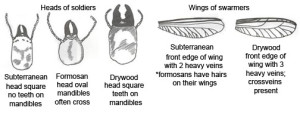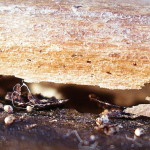There are three main types of termites that can cause problems for homeowners in Central Texas- native subterranean termites, formosan subterranean termites and drywood termites. To identify termites you will need to obtain soldiers (ones with a hard head with large mandibles) or reproductives with wings.
Native subterranean termites have nests in the soil and must maintain contact with soil or an above-ground moisture source to survive. If native subterranean termites move to areas above ground they make shelter (mud) tubes of fecal material, saliva and soil to protect themselves.
Formosan termites are a more voracious type of subterranean termite. These termites have been spread throughout Texas through transport of infested material or soil. Formosan termites build carton nests that allow them to survive above ground without contact with the soil. Nests are often located in hollow spaces, such as wall voids.
Formosan termites feed on a wider variety of cellulose that other subterranean termites, including live plants, consuming both spring and summer growth whereas native subterranean termites feed only on spring growth. Formosan termites have also been known to chew through non-cellulose materials such as soft metals, plaster or plastic.
Drywood termites do not need contact with soil and reside in sound, dry wood. These termites obtain moisture from the wood they digest. Drywood termites create a dry fecal pellet that can be used as an identifying characteristic. They have smaller colonies- around 1,000 termites- than subterranean termites; they also do not build shelter tubes.
If you are concerned that you may have termites, call a pest management professional to inspect your home for termites.



